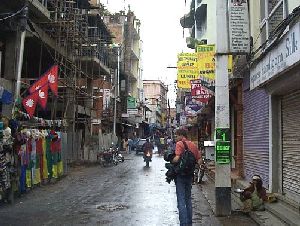
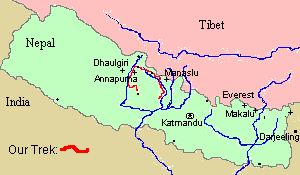
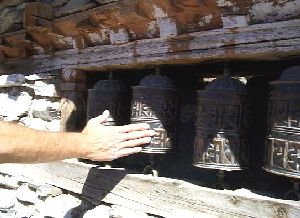

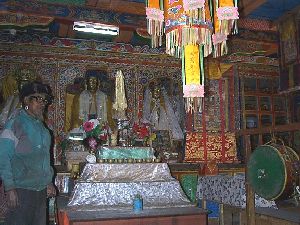
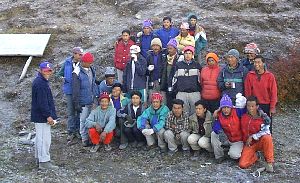
|
Katmandu
Yeow! Loud, odiferous, and visually stimulating, the big K can give you cultural whiplash if this is your first taste of a large, third world city. During my first day in the city, I was scared to death of getting lost, intimidated by the lack of street signs, appalled by the proliferation of beggars, disgusted by the open garbage heaps. I couldn't wait to get out onto the trek.
What was interesting was the change in attitude I had on returning to Katmandu three weeks later. Back alley shortcuts didn't freak me out so much, the beggars we easily ignored, and Bob and I spent a memorable evening bar hopping. It is a city that takes some getting used to. Like most large cities, it is really quite nice if you can get past your initial impressions.
The Annapurna Circuit
The Annapurna Circuit trek is probably the most popular trek in Nepal. Although the Everest base camp trek is more well known to Americans, the Annapurna Circuit draws more hikers overall. In a typical year, as many as 20,000 people do the trek. It is also one of the longest treks, since it is a 180 mile loop around an entire range of mountains.
The Circuit is located in central Nepal near the Tibet border. Thus, there were many signs of the Buddhist influence on the area; from prayer wheels, mani stone walls, and Buddhist monastaries called Gompas.
A Mob Scene
We chose to do a guided camping trek. That means that we had a staff of guides and porters with us and that we camped out in tents most nights. Our staff consisted of a head guide or sidar who was like a general manager. He organized everything and was the liaison with us non-Nepali speakers. We also had 3 assistant guides who stayed with us on the trail. The kitchen crew consisted of a head cook and 4 assistants. And finally, we had 16 porters carrying our luggage, tents, and food. All this for nine American tourists! It seems like quite an unmanageable crowd, but as we were seldom all in the same place at the same time, it wasn't too bad.
|